Here at Bluleadz, we are always striving to stay ahead of the curve when it comes to inbound marketing best practices.
So, when we were recently invited to participate in a selective HubSpot Partner Agency online workshop, the team was thrilled and ready to jump right in!
I will say that we weren't sure what to expect from a virtual "workshop," but we were excited to find out. What we got in return far exceeded our expectations.
Justin Champion (@JustinRChampion), Content Professor for HubSpot Academy and Creator of HubSpot's Content Marketing Certification Course, put together a webinar-style workshop with the intention of having us outline a long-term content marketing strategy framework for one of our clients.
We got a presentation and a workbook all in one. The team gave five-star reviews on the format as 1) it was easy to follow along on the ideas and concepts, and 2) they were able to implement these concepts in real time.
The best part was that we walked away with 10 new content strategy ideas for 10 separate clients (each team member in the meeting created one for a different client).
In this workshop, we learned how to brainstorm, plan, and create effective content for our clients based on the newer content marketing landscape while utilizing pillar page concepts HubSpot has been leading up.
Below is a recap of some of my key takeaways from the workshop, as well as a step-by-step guide to how you, too, can create an effective, long-term content marketing strategy for your business or clients.
The Landscape of Content Marketing Today
One of the key quotes I took away from this presentation was, "Content is becoming a business-wide initiative, not just a marketing initiative." Companies are increasingly seeing non-marketing employees become part of the content creation process, which allows higher quality content to be produced.
The landscape of content is extremely cluttered; to create effective content, you need to determine WHY you’re creating it in the first place.
Once you figure out your WHY, there are a couple other things to keep in mind. You need to make sure you're writing for users and not just search engines, as people will ultimately be interacting with your content. Also, pay close attention to HOW people are now consuming content.
This presentation was largely based on the fact that users are consuming long-form content. Marketers have seen the benefit of this by launching ungated website pages, which are basically eBooks without a required information form. When Justin launched an ungated page on his website, he saw a 943% increase in organic traffic in 13 months.
This segues perfectly into the pillar page concept, which was the focus of this presentation. A Content Pillar (aka pillar page) is a website page that covers a broad topic in depth and is linked to a cluster of related content.
By creating pillar pages on your website, visitors are able to get the information they want right away, and then you can offer it as a packaged resource, such as a downloadable PDF, to encourage users to download it and take it with them.
So, this sounds great and all, but how is this actually implemented? It seems like a lot of work. Well, that is where the workshop portion of this presentation came in handy. Below I have outlined the six steps to reverse engineer a resource pillar page—the same way we did in the workshop—so that you can implement it for your company or clients.
Reverse Engineering a Resource Pillar Page
You first must start with a content mission statement. I found this very interesting as well. You want to be aware of what your content really stands for and how it makes a difference in the lives of your audience. This is what will set the tone for your entire marketing strategy. See the example below: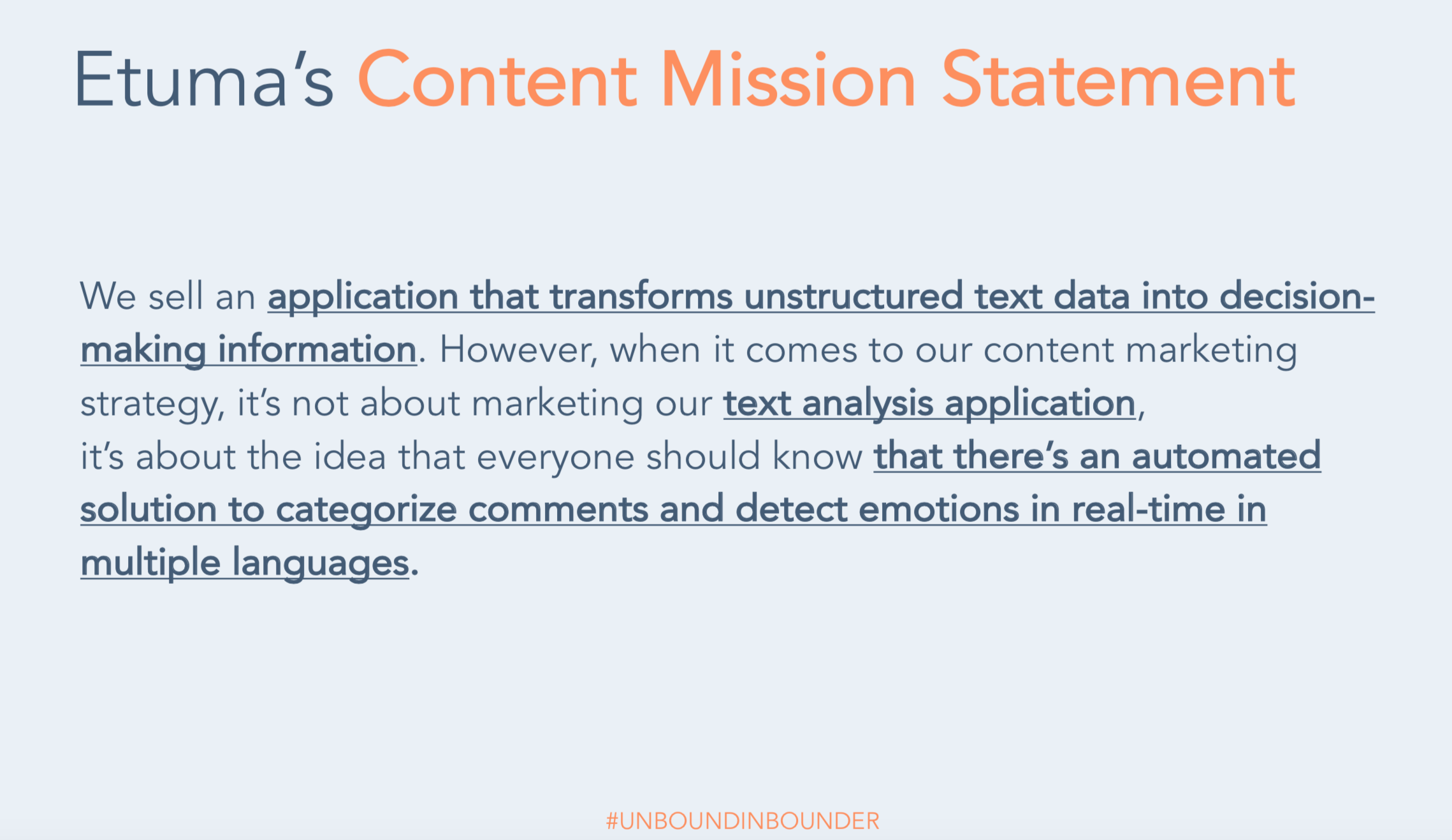
Go ahead and use that same format, but filling in the bolded parts to be specific to your company or client.
Now it's time to work on your content pillar.
There are two types of pillar pages you can create:
- Resource Pillar Page: This is a page that is heavy on internal and/or external links; it's a "bookmarkable reference page."
- 10X Content Pillar Page: This is a deep dive on a core topic. The format is similar to an ungated eBook.
The following reverse engineering steps are in reference to creating a 10X content pillar page. The idea is to work backwards to create a valuable piece of long-form content by recycling a series of planned content initiatives.
The following image does a great job of visually showing your core topic—in this case, "encryption key management," which will be the focus of your pillar page—and all of the sub-topics that you can associate with your core topic. So, let's dive in...
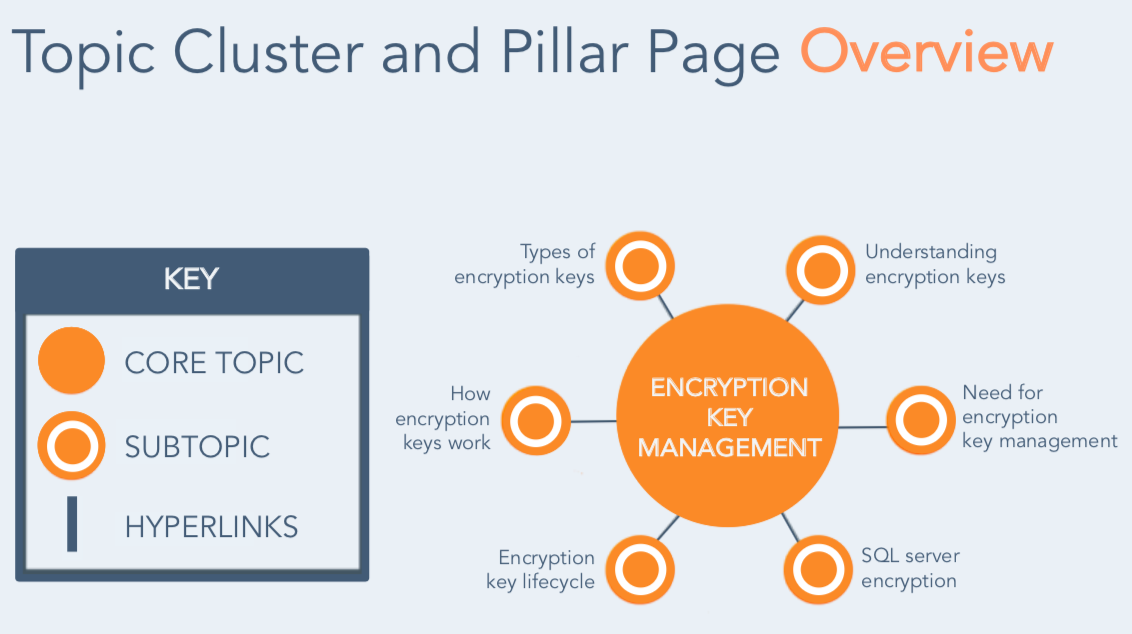
1. Determine Your Head Term
The example used in our presentation referenced Colgate's "Gum Disease" pillar page. As such, I will use examples from that throughout to help tie everything together for you.
Your head term should be a topic that is relevant to one of your company's/your client's products or services. This is typically two words long (but can be up to four) and should have a search volume of at least 2,500 per month. You can perform research on Google to find potential head terms.
You can utilize this helpful Keywords Everywhere plugin to help you find the monthly search volume of keywords.
From Colgate's research, they chose gum disease as their head term and created an entire in-depth resource page around it. Each section of the page links to relevant resources for continued learning.
2. Identify Your Core Topics
Your core topics should support your head term. Each of these topics are typically three to five words in length. Again, perform research on Google to find potential core topics. You can type your head term into Google and use Google's Autocomplete feature in the search bar, or check out related searches at the bottom of the page as well to get core topic ideas.
However, be sure not to just stop at finding core topics. Click through the articles on the first page of results and review the page content. Is it up to date? What is the searcher's intent?
The goal here is to rank for each core topic. One of Colgate's core topics was "Gum Disease Prevention."
3. Identify Subtopics for One of the Core Topics
Your core topics should be supported with subtopic content assets. Think of each piece of subtopic content as one more step toward your core topic visibility.
Colgate's example, "How to Fight Gingivitis in 3 Easy Steps" was a subtopic related to Gum Disease Prevention, their core topic.
4. Build Your Pillar Page
Now that you have your content outline, it is time to build your page! Below are two key slides that can help with the layout of your pillar page and how it should be structured.
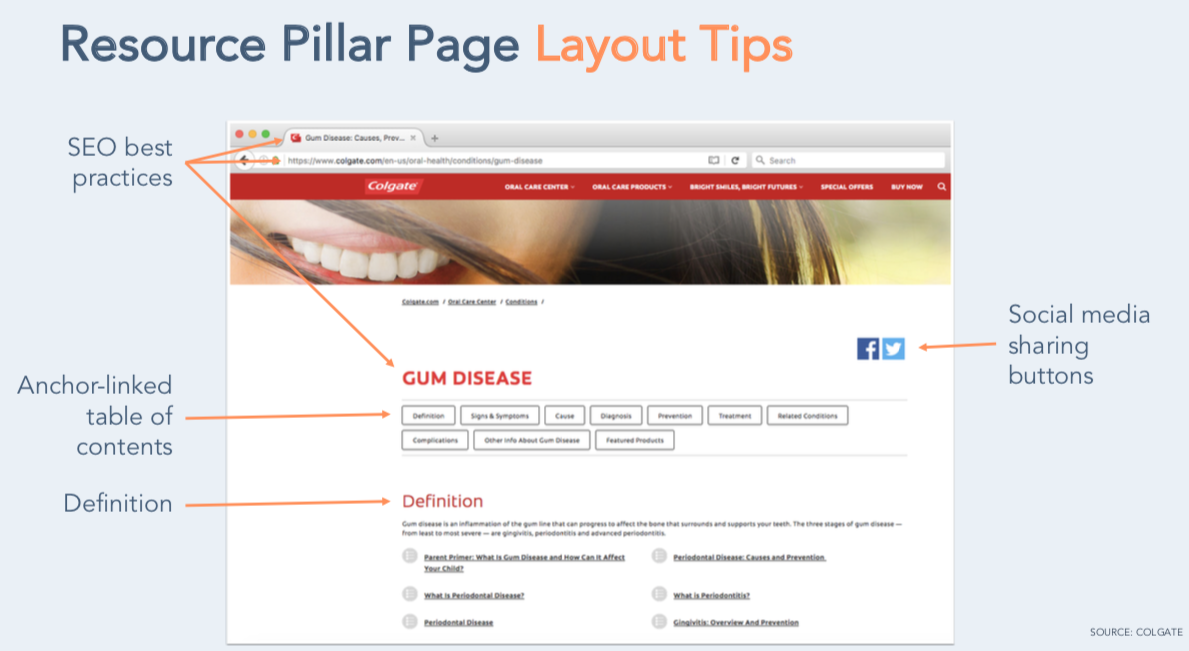
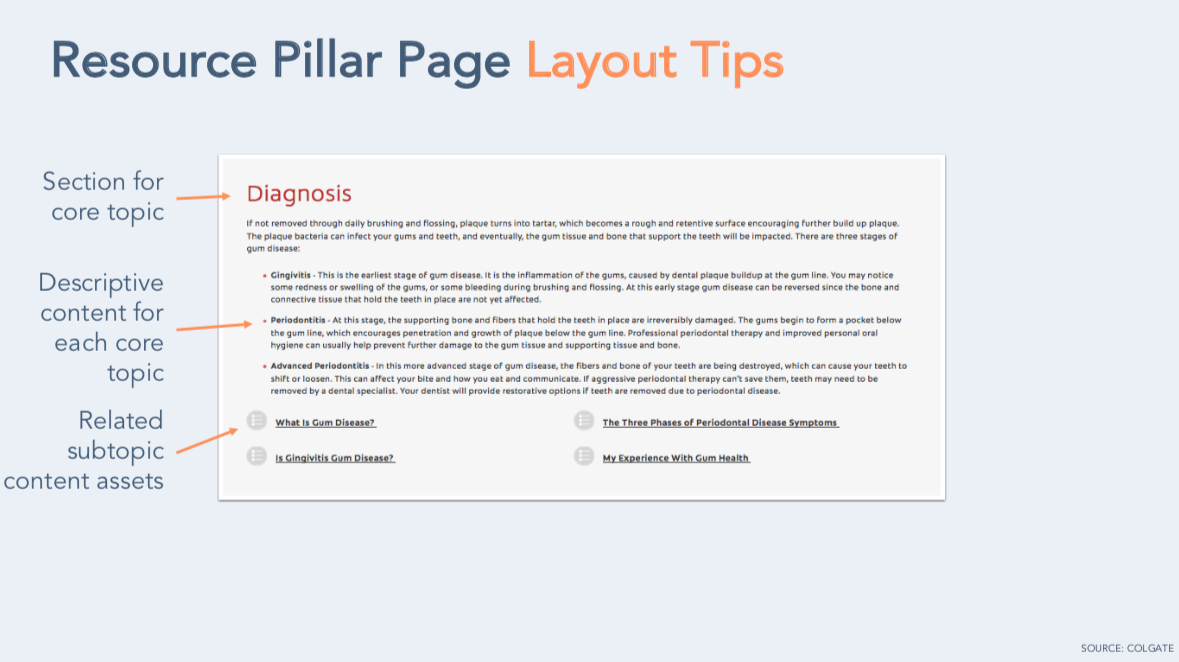
You also can utilize HubSpots free pillar page templates to help get you started!
If you are a visual/example based learner (like me), here are a few more examples that were referenced in our presentation of pillar pages:
- Wild We Wander DIY Truck Camper
- Etuma— Text Analysis
- Colgate — Gum Disease
- HubSpot Academy's Contact Management
5. Link All Related Content to Your Pillar Page
Now here is a very important part! You MUST make sure all of your subtopics link to the resource pillar page. While you don't have to list all of your subtopics on your pillar page, it is imperative that you link to the pillar page from each of your subtopic pages.
6. Increase Website Authority via Inbound Links
Inbound links are a critical piece of your marketing plan, as they help you to increase your website authority. The quality and quantity of your inbound links matter greatly.
If you are interested in learning more about SEO and link building strategy, HubSpot Academy has a track to help get you started.
Getting Started
Wow, that was a lot to cover! After reading through all of that information, it is easy to feel overwhelmed. To get started, focus your time and energy on creating your first topic cluster.
This will help make managing your content easier and less overwhelming. You can reverse engineer packaged content resources by making sense of your weekly content tasks.
An example from HubSpot showed how they wanted to support their free CRM with contact management themed content. The initiative was a 23-part blog series on contact management.
In order to make a bigger impact, HubSpot's Email and Contacts Professor, Courtney Sembler, broke the content into four different core topics around contact management and created each blog post over the course of six months.
Sembler then repurposed her blog series into packaged resources. From there, she used all of her content to create a resource pillar page. Each core topic section offers a call-to-action to a relevant offer.
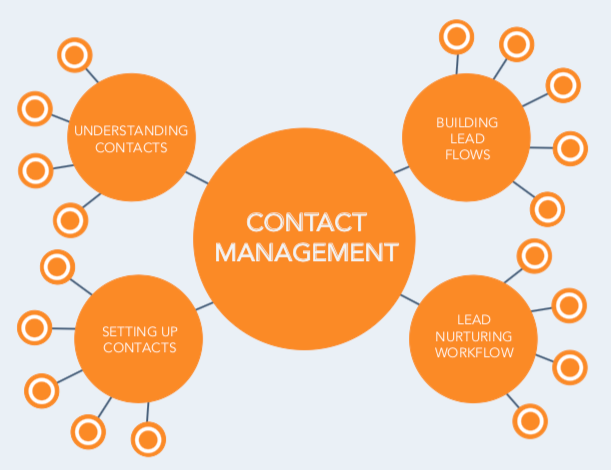
While it takes proper planning, reference the six steps above and you'll be on your way to creating an effective pillar page and supporting content in no time! You also can use this diagram to focus on the steps to make the entire process seem simplified and more attainable.
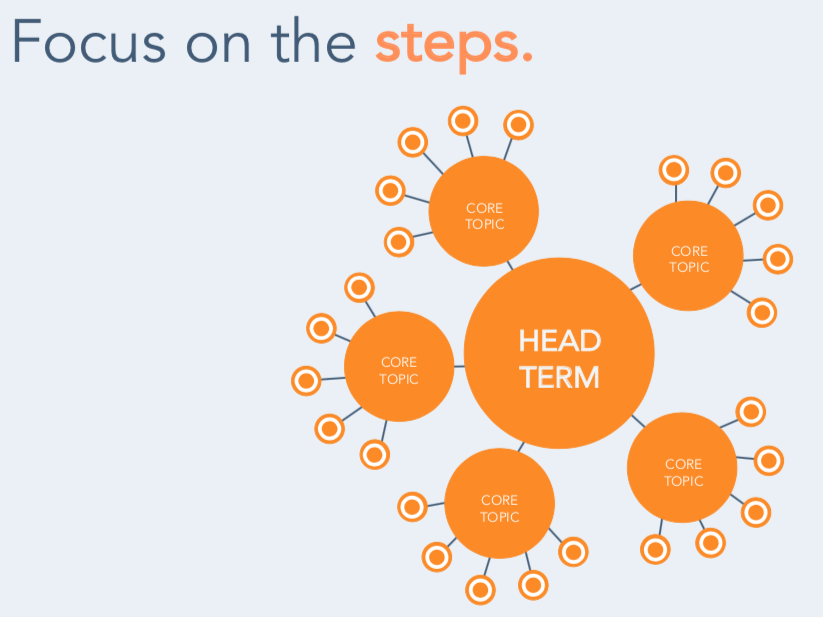
If you have any questions on creating pillar page content, please feel free to reach out to me directly or contact Bluleadz for more information! You also can learn more about inbound content by ordering Justin's new book!

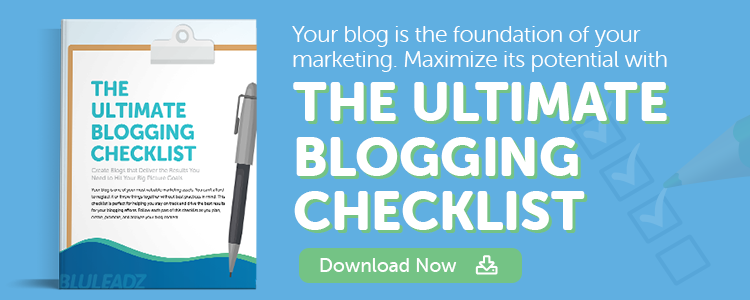
Brittany Balog
Brittany is an Inbound Marketing Consultant for BluLeadz who enjoys traveling, live music, the beach and Steelers football.